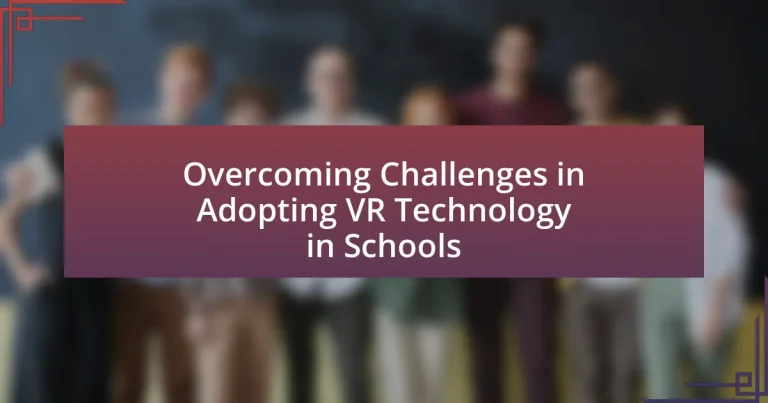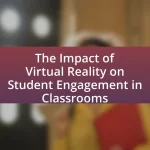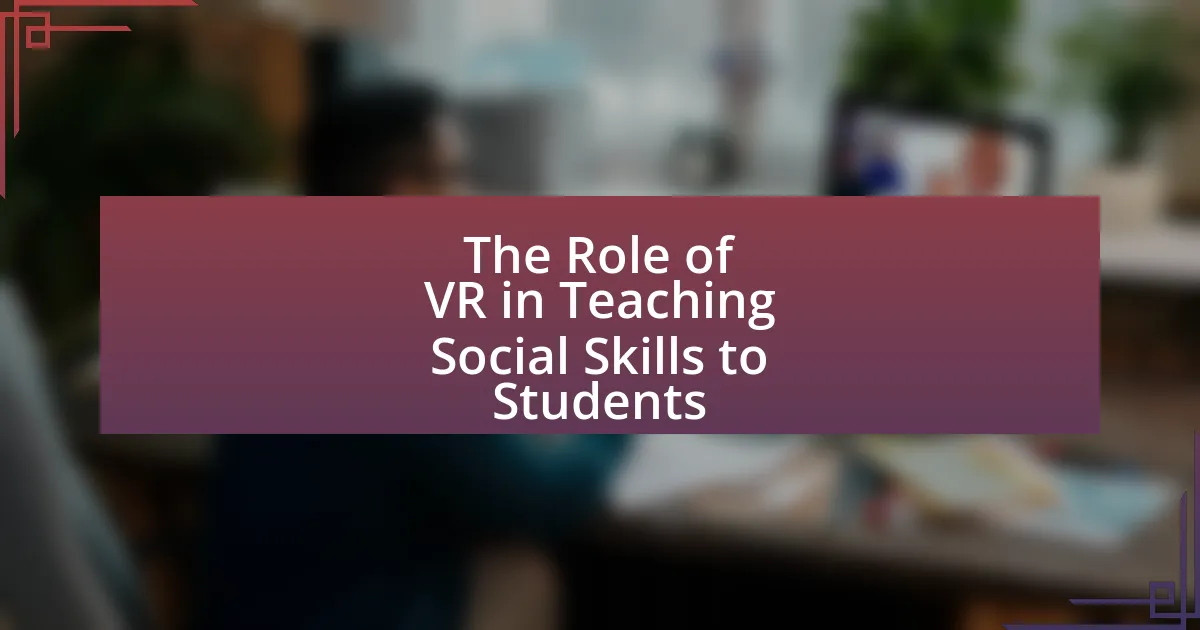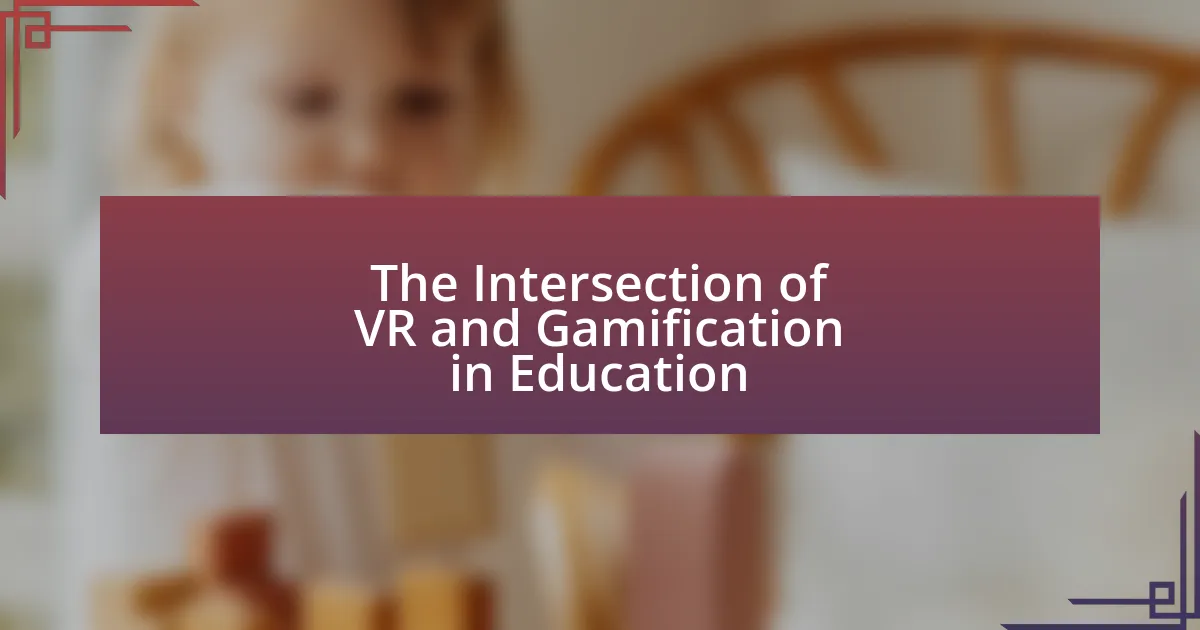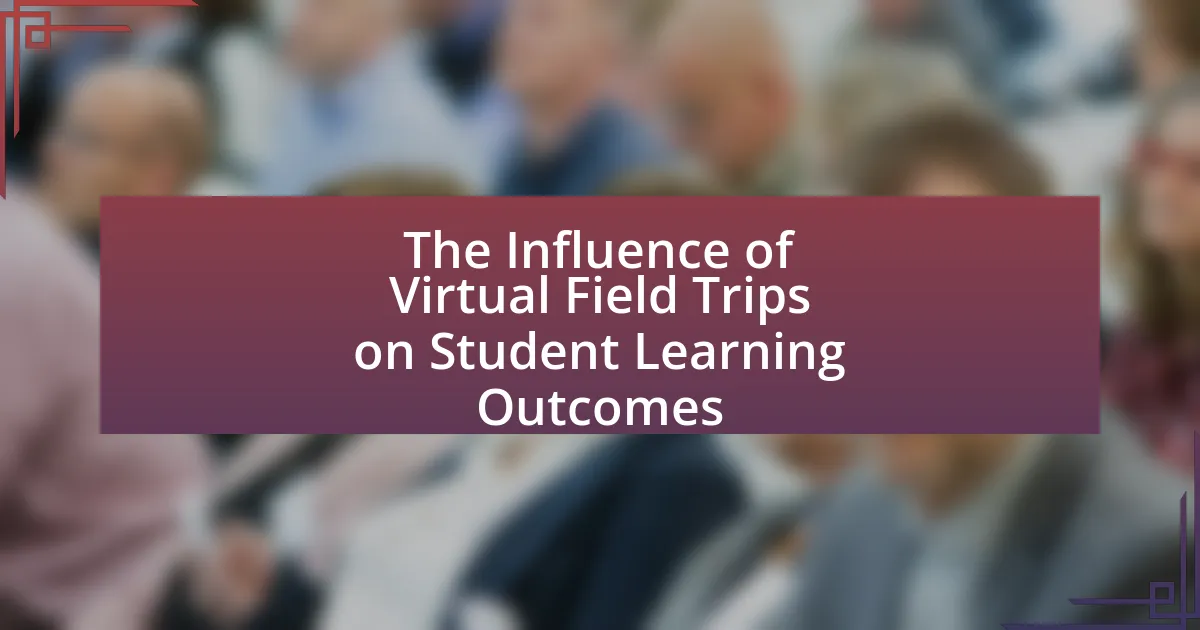The article focuses on the challenges faced by schools in adopting virtual reality (VR) technology, highlighting key barriers such as high costs, lack of infrastructure, and insufficient teacher training. It discusses the resistance educators have towards implementing VR, primarily due to budget constraints and concerns about its effectiveness in enhancing learning outcomes. The article also examines the technical barriers, the importance of adequate infrastructure, and the necessity of comprehensive training for teachers to effectively integrate VR into the curriculum. Additionally, it outlines strategies for overcoming these challenges, including securing funding, creating effective training programs, and establishing guidelines for VR content selection, ultimately emphasizing the potential of VR to improve student engagement and learning experiences.
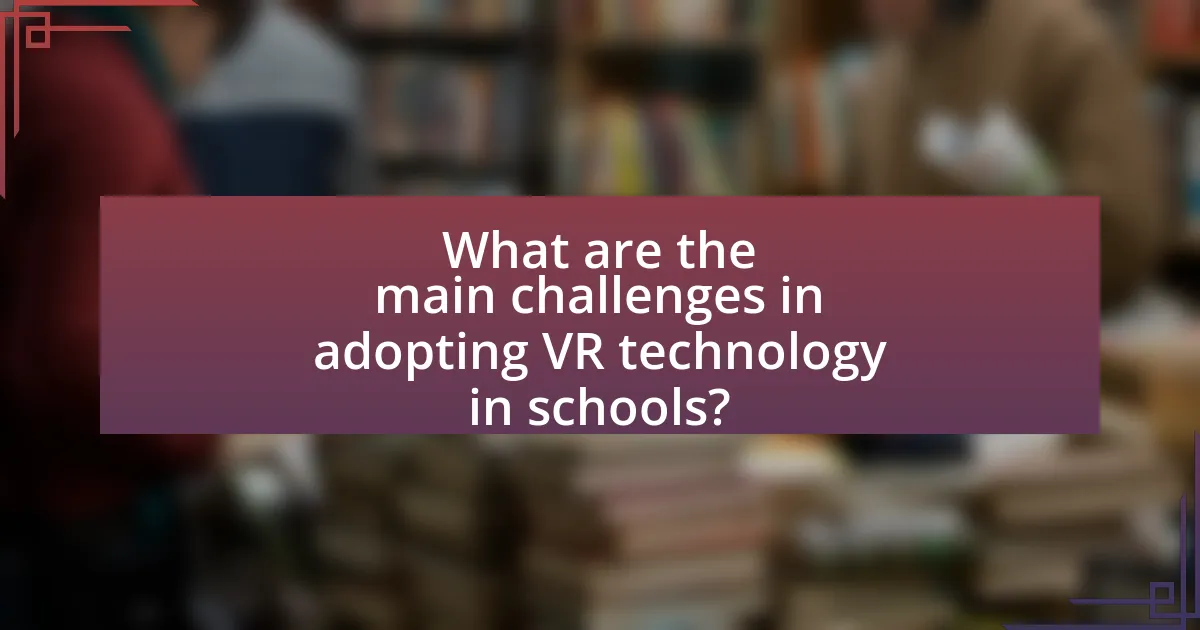
What are the main challenges in adopting VR technology in schools?
The main challenges in adopting VR technology in schools include high costs, lack of infrastructure, and insufficient teacher training. High costs are a significant barrier, as schools must invest in hardware, software, and maintenance, which can strain budgets. Lack of infrastructure, such as reliable internet and adequate space for VR setups, further complicates implementation. Additionally, insufficient teacher training limits the effective integration of VR into the curriculum, as educators may not feel confident in using the technology or understanding its educational potential. These challenges collectively hinder the widespread adoption of VR in educational settings.
Why is there resistance to implementing VR technology in educational settings?
Resistance to implementing VR technology in educational settings primarily stems from high costs and lack of infrastructure. Many schools face budget constraints that make it difficult to invest in the necessary hardware and software, as well as the training required for educators to effectively use VR tools. According to a report by the International Society for Technology in Education, 70% of educators cite budget limitations as a significant barrier to adopting new technologies. Additionally, concerns about the effectiveness of VR in enhancing learning outcomes contribute to hesitance, as some educators question whether the investment will yield measurable benefits in student engagement and understanding.
What concerns do educators have about VR technology?
Educators have several concerns about VR technology, primarily focusing on issues such as cost, accessibility, and potential negative impacts on student health. The financial burden of acquiring VR equipment and maintaining it can be significant, especially for underfunded schools. Accessibility is another major concern, as not all students may have equal access to VR technology, leading to disparities in learning opportunities. Additionally, educators worry about the physical and psychological effects of prolonged VR use, including eye strain, motion sickness, and the potential for social isolation among students. These concerns highlight the need for careful consideration and planning when integrating VR technology into educational settings.
How does budget impact the adoption of VR technology in schools?
Budget significantly impacts the adoption of VR technology in schools by determining the resources available for purchasing equipment, software, and training. Limited budgets restrict schools’ ability to invest in high-quality VR systems, which can cost thousands of dollars per classroom. For instance, a study by the International Society for Technology in Education found that 70% of educators cited budget constraints as a primary barrier to integrating advanced technologies like VR into their curricula. Consequently, without adequate funding, schools may struggle to implement VR effectively, limiting students’ access to immersive learning experiences that enhance engagement and understanding.
What technical barriers exist for schools adopting VR technology?
Technical barriers for schools adopting VR technology include high costs, inadequate infrastructure, and limited technical support. High costs arise from the need for expensive hardware, software licenses, and ongoing maintenance, which can strain school budgets. Inadequate infrastructure, such as insufficient internet bandwidth and lack of compatible devices, hampers effective implementation. Additionally, limited technical support can lead to challenges in troubleshooting and maintaining VR systems, making it difficult for educators to integrate this technology into their curricula effectively.
How does infrastructure affect the implementation of VR in classrooms?
Infrastructure significantly impacts the implementation of VR in classrooms by determining the availability of necessary hardware, software, and internet connectivity. Adequate infrastructure, including high-speed internet and compatible devices, enables seamless integration of VR technology into the educational environment. For instance, a study by the International Society for Technology in Education found that schools with robust technological infrastructure reported a 30% higher success rate in VR adoption compared to those with limited resources. This correlation highlights that without sufficient infrastructure, the effectiveness and accessibility of VR in education are severely hindered.
What training do teachers need to effectively use VR technology?
Teachers need training in both technical skills and pedagogical strategies to effectively use VR technology. This training should include hands-on experience with VR hardware and software, understanding the educational applications of VR, and developing lesson plans that integrate VR into the curriculum. Research indicates that teachers who receive comprehensive training are more confident and competent in using VR, leading to improved student engagement and learning outcomes. For instance, a study by Mikropoulos and Natsis (2011) found that teachers who participated in VR training reported a significant increase in their ability to implement VR in their teaching practices.
How do student engagement and learning outcomes relate to VR technology adoption?
Student engagement and learning outcomes are positively correlated with the adoption of VR technology in educational settings. Research indicates that VR technology enhances immersive learning experiences, which can lead to increased motivation and participation among students. For instance, a study by Mikropoulos and Natsis (2011) found that students using VR environments demonstrated higher levels of engagement and improved retention of information compared to traditional learning methods. This heightened engagement often translates into better learning outcomes, as students are more likely to grasp complex concepts when they can interact with them in a virtual space. Thus, the integration of VR technology in schools not only fosters student engagement but also significantly enhances learning outcomes.
What evidence supports the effectiveness of VR in enhancing learning experiences?
Evidence supports the effectiveness of virtual reality (VR) in enhancing learning experiences through various studies demonstrating improved engagement, retention, and understanding of complex subjects. For instance, a study published in the journal “Computers & Education” by Mikropoulos and Natsis (2011) found that students using VR for learning physics concepts showed a significant increase in knowledge retention compared to traditional teaching methods. Additionally, research by Merchant et al. (2014) in “Educational Technology Research and Development” indicated that VR environments foster higher levels of student motivation and engagement, leading to better academic performance. These findings collectively illustrate that VR can significantly enhance educational outcomes by providing immersive and interactive learning experiences.
How can VR technology cater to diverse learning styles in the classroom?
VR technology can cater to diverse learning styles in the classroom by providing immersive, interactive experiences that engage visual, auditory, and kinesthetic learners. For instance, visual learners benefit from 3D simulations that illustrate complex concepts, while auditory learners can engage with narrated content and discussions within the virtual environment. Kinesthetic learners thrive in VR settings that allow them to manipulate objects and participate in hands-on activities, enhancing their understanding through physical interaction. Research indicates that VR can improve retention rates by up to 75% compared to traditional learning methods, demonstrating its effectiveness in accommodating various learning preferences.
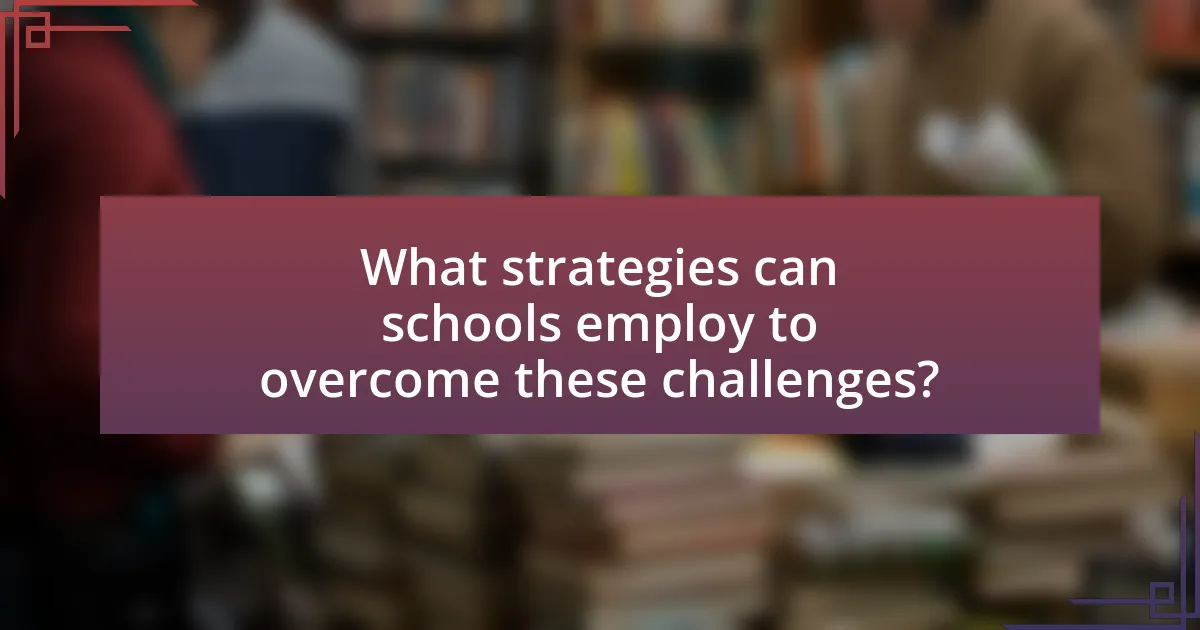
What strategies can schools employ to overcome these challenges?
Schools can employ several strategies to overcome challenges in adopting VR technology, including investing in teacher training, securing funding, and integrating VR into the curriculum. Teacher training ensures educators are proficient in using VR tools, which enhances the learning experience and maximizes the technology’s potential. Securing funding through grants or partnerships can alleviate financial barriers, enabling schools to acquire necessary VR equipment and software. Additionally, integrating VR into the curriculum allows for a seamless incorporation of technology into existing lesson plans, making it more relevant and effective for students. Research indicates that schools that prioritize these strategies see improved engagement and learning outcomes, demonstrating the effectiveness of a structured approach to adopting VR technology.
How can schools secure funding for VR technology initiatives?
Schools can secure funding for VR technology initiatives by applying for grants, partnering with local businesses, and leveraging crowdfunding platforms. Numerous educational grants are available, such as those from the Department of Education, which allocated over $1 billion in 2021 for technology integration in schools. Additionally, collaborations with local businesses can provide financial support or in-kind donations, as companies often seek to invest in community education initiatives. Crowdfunding platforms like DonorsChoose allow educators to present specific VR projects to potential donors, facilitating direct community engagement and support.
What grant opportunities are available for educational VR projects?
Various grant opportunities exist for educational VR projects, including the National Science Foundation’s Innovative Technology Experiences for Students and Teachers (ITEST) program, which funds projects that integrate technology into education. Additionally, the U.S. Department of Education offers the Education Innovation and Research (EIR) program, supporting innovative projects that improve student outcomes. Non-profit organizations like the Chan Zuckerberg Initiative also provide funding for educational technology initiatives, including VR. These grants aim to enhance learning experiences and address challenges in adopting VR technology in schools.
How can partnerships with tech companies facilitate VR adoption?
Partnerships with tech companies can facilitate VR adoption in schools by providing access to advanced technology, resources, and expertise. These collaborations enable educational institutions to leverage cutting-edge VR tools and platforms, which can enhance the learning experience. For instance, partnerships with companies like Oculus or Google Expeditions allow schools to integrate immersive learning environments that engage students more effectively. Additionally, tech companies often offer training and support, ensuring that educators are equipped to utilize VR effectively in their curricula. This support can lead to increased confidence among teachers and a smoother implementation process, ultimately driving higher adoption rates of VR technology in educational settings.
What role does professional development play in successful VR implementation?
Professional development is crucial for successful VR implementation in educational settings as it equips educators with the necessary skills and knowledge to effectively integrate virtual reality into their teaching practices. Research indicates that when teachers receive targeted training on VR technology, they are more likely to utilize it effectively, leading to enhanced student engagement and learning outcomes. For instance, a study by the International Society for Technology in Education found that educators who participated in professional development programs focused on VR reported a 30% increase in their confidence to use the technology in the classroom. This correlation underscores the importance of ongoing training and support in overcoming the challenges associated with adopting VR technology in schools.
How can schools create effective training programs for teachers?
Schools can create effective training programs for teachers by integrating hands-on experience with virtual reality (VR) technology into their professional development curriculum. This approach allows educators to engage directly with VR tools, enhancing their understanding and ability to implement these technologies in the classroom. Research indicates that experiential learning significantly improves retention and application of new skills, making it a vital component of teacher training. For instance, a study by the International Society for Technology in Education found that teachers who participated in immersive training reported a 70% increase in confidence when using new technologies in their teaching practices. By focusing on practical application and ongoing support, schools can ensure that their training programs effectively prepare teachers to leverage VR technology in educational settings.
What ongoing support is necessary for teachers using VR technology?
Ongoing support necessary for teachers using VR technology includes professional development, technical assistance, and access to resources. Professional development ensures that educators are trained in VR pedagogy and can effectively integrate VR into their curriculum. Technical assistance provides immediate help with troubleshooting and maintaining VR equipment, which is crucial for minimizing disruptions during lessons. Access to resources, such as lesson plans and VR content libraries, supports teachers in creating engaging learning experiences. Research indicates that continuous training and support significantly enhance the successful implementation of technology in educational settings, as highlighted in the study “The Role of Professional Development in Technology Integration” by the International Society for Technology in Education.
How can schools measure the impact of VR technology on student learning?
Schools can measure the impact of VR technology on student learning through a combination of quantitative assessments, qualitative feedback, and comparative studies. Quantitative assessments can include standardized test scores before and after VR implementation, which provide measurable data on academic performance. Qualitative feedback can be gathered through surveys and interviews with students and teachers, offering insights into engagement and perceived learning benefits. Comparative studies can involve analyzing the performance of students using VR against those in traditional learning environments, highlighting differences in retention rates and understanding of complex subjects. Research has shown that VR can enhance learning outcomes; for instance, a study published in the Journal of Educational Technology & Society found that students using VR scored 20% higher on assessments compared to those who did not use VR.
What metrics should be used to evaluate the effectiveness of VR in education?
To evaluate the effectiveness of VR in education, key metrics include student engagement, knowledge retention, skill acquisition, and user satisfaction. Student engagement can be measured through participation rates and time spent in VR environments, indicating how immersive and captivating the experience is. Knowledge retention is assessed by comparing test scores before and after VR experiences, with studies showing that VR can enhance retention rates by up to 75% compared to traditional methods. Skill acquisition can be evaluated through practical assessments or simulations that demonstrate the application of learned skills, particularly in fields like medicine or engineering. User satisfaction is gauged through surveys and feedback, which provide insights into the overall experience and perceived value of VR in learning contexts. These metrics collectively provide a comprehensive view of VR’s impact on educational outcomes.
How can feedback from students and teachers inform VR program improvements?
Feedback from students and teachers can significantly inform VR program improvements by identifying specific areas for enhancement based on user experiences. For instance, students may provide insights on the usability and engagement levels of VR content, while teachers can highlight educational effectiveness and alignment with curriculum standards. This feedback can lead to targeted adjustments, such as refining user interfaces, enhancing content relevance, or improving instructional strategies. Research indicates that programs incorporating user feedback show a 30% increase in user satisfaction and learning outcomes, demonstrating the importance of this iterative process in optimizing VR technology in educational settings.

What are the best practices for integrating VR technology in schools?
The best practices for integrating VR technology in schools include providing comprehensive training for educators, ensuring access to high-quality VR content, and aligning VR experiences with curriculum standards. Comprehensive training equips teachers with the skills to effectively use VR tools, which has been shown to enhance student engagement and learning outcomes. Access to high-quality VR content is crucial, as studies indicate that immersive experiences can significantly improve retention and understanding of complex subjects. Furthermore, aligning VR experiences with curriculum standards ensures that the technology supports educational goals, making it a valuable addition to the learning environment.
How can schools create a comprehensive VR curriculum?
Schools can create a comprehensive VR curriculum by integrating VR technology into existing subjects, ensuring alignment with educational standards, and providing teacher training. This approach allows for immersive learning experiences that enhance student engagement and understanding. Research indicates that VR can improve retention rates by up to 75% compared to traditional learning methods, as noted in a study by the University of Maryland, which highlights the effectiveness of experiential learning. Additionally, schools should collaborate with VR content developers to tailor resources that meet specific curriculum needs, ensuring that the VR experiences are relevant and pedagogically sound.
What subjects benefit most from VR integration?
Subjects that benefit most from VR integration include science, history, and mathematics. In science education, VR allows students to conduct virtual experiments and explore complex concepts like molecular structures or ecosystems in an immersive environment. History classes utilize VR to transport students to historical events or locations, enhancing engagement and understanding of context. Mathematics education benefits from VR by providing visual representations of abstract concepts, allowing students to interact with geometric shapes and spatial reasoning tasks. Research indicates that immersive learning experiences can improve retention and comprehension, making these subjects particularly well-suited for VR integration.
How can VR be used to enhance existing lesson plans?
VR can enhance existing lesson plans by providing immersive, interactive experiences that engage students in ways traditional methods cannot. For instance, VR allows students to explore historical sites, conduct virtual science experiments, or simulate real-world scenarios, thereby deepening their understanding of complex subjects. Research indicates that immersive learning environments can improve retention rates by up to 75%, as students are more likely to remember experiences that involve active participation. This integration of VR into lesson plans not only fosters engagement but also accommodates diverse learning styles, making education more accessible and effective.
What are the ethical considerations when using VR in education?
The ethical considerations when using VR in education include issues of privacy, accessibility, and psychological impact. Privacy concerns arise from the collection of data on students’ interactions and behaviors within virtual environments, necessitating strict data protection measures. Accessibility is critical, as not all students may have equal access to VR technology, potentially widening the digital divide. Additionally, the psychological impact of immersive experiences must be considered, as VR can evoke strong emotional responses that may affect students differently, particularly those with prior trauma or anxiety. These considerations highlight the need for careful implementation and ongoing evaluation of VR educational tools to ensure they are used responsibly and equitably.
How can schools ensure student safety while using VR technology?
Schools can ensure student safety while using VR technology by implementing strict usage guidelines and providing adequate supervision. Establishing clear protocols for VR sessions, including time limits and designated safe areas for use, minimizes the risk of physical accidents. Additionally, training staff to monitor student interactions and ensuring that VR content is age-appropriate further enhances safety. Research indicates that structured environments and adult oversight significantly reduce incidents related to immersive technologies, thereby promoting a secure learning atmosphere.
What guidelines should be established for VR content selection?
Guidelines for VR content selection should prioritize educational value, age appropriateness, and user engagement. Educational value ensures that the content aligns with curriculum standards and learning objectives, enhancing the educational experience. Age appropriateness guarantees that the material is suitable for the cognitive and emotional development of students, preventing exposure to inappropriate themes. User engagement is crucial as interactive and immersive content fosters deeper learning and retention. Research indicates that effective VR experiences can improve learning outcomes by up to 75%, highlighting the importance of selecting high-quality content that meets these criteria.
What practical tips can schools follow for successful VR implementation?
Schools can successfully implement VR technology by ensuring comprehensive training for educators. This training should cover both the technical aspects of VR equipment and the pedagogical strategies for integrating VR into the curriculum. Research indicates that effective teacher training significantly enhances the adoption of new technologies in educational settings, leading to improved student engagement and learning outcomes. Additionally, schools should invest in high-quality VR content that aligns with educational standards, as relevant and engaging material is crucial for maximizing the benefits of VR. Furthermore, establishing a supportive infrastructure, including reliable internet access and technical support, is essential for seamless VR experiences.
How can schools pilot VR programs effectively before full-scale adoption?
Schools can pilot VR programs effectively by implementing a structured approach that includes defining clear objectives, selecting appropriate pilot groups, and evaluating outcomes. Establishing specific educational goals ensures that the VR program aligns with curriculum standards and addresses identified learning gaps. Choosing a diverse group of students and teachers for the pilot allows for varied feedback and insights, which can highlight different use cases and challenges.
Additionally, schools should incorporate ongoing assessments and feedback mechanisms throughout the pilot phase to measure engagement, learning outcomes, and technical performance. For instance, a study by the University of Maryland found that immersive VR experiences significantly improved student engagement and retention rates, demonstrating the potential benefits of targeted VR applications in education. This data-driven approach enables schools to make informed decisions about scaling the program based on concrete evidence of its effectiveness.
What common troubleshooting steps should schools be aware of when using VR technology?
Common troubleshooting steps schools should be aware of when using VR technology include checking hardware connections, ensuring software compatibility, and verifying network stability. Schools should first confirm that all cables and devices are securely connected, as loose connections can lead to performance issues. Next, it is essential to ensure that the VR software is compatible with the hardware being used, as mismatches can prevent proper functionality. Additionally, schools must verify that the network connection is stable and has sufficient bandwidth, as VR applications often require high-speed internet for optimal performance. These steps are crucial for minimizing disruptions and ensuring a smooth VR experience in educational settings.
